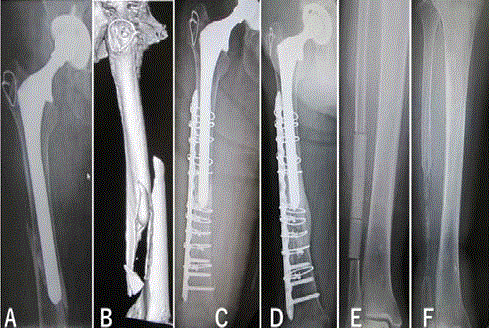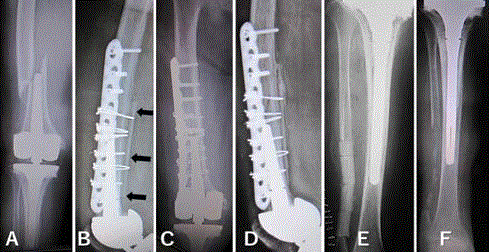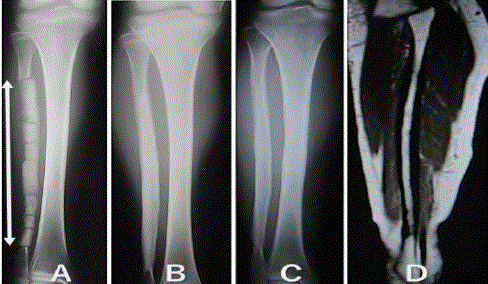Research Article
Autogenous Fibula Graft for Periprosthetic Femoral Fractures after Revision Total Hip or Knee Arthroplasty
Yoshio Kumagae and Takaaki Tanaka*
Department of Orthopaedic Surgery, NHO Utsunomiya National Hospital, Japan
*Corresponding author: Takaaki Tanaka, Department of Orthopaedic Surgery, NHO Utsunomiya National Hospital, 2160 Shimo- Okamoto, Utsunomiya city, Tochigi 329- 1103, Japan
Published: 01 Nov, 2018
Cite this article as: Kumagae Y, Tanaka T. Autogenous
Fibula Graft for Periprosthetic Femoral
Fractures after Revision Total Hip or
Knee Arthroplasty. Clin Surg. 2018; 3:
2189.
Abstract
Periprosthetic femoral fractures after total hip and knee arthroplasty are increasing common
complications. With stable prosthesis classified Vancouver type B1, surgical stabilization of the
fracture with plate, strut allograft, or a combination of both is recommended. However, allografts
have not commonly been used in Japan. In addition, bone formation and stabilization in the
fractured site are not easily obtained after revision THA and TKA using long stem. Thus, we used
autogenous fibula graft and plate in the treatment of periprosthetic femoral fractures after three
revisions THA and one revision TKA. In addition, to reduce donor-site morbidity, Beta-Tricalcium
Phosphate (TCP) blocks were placed on the periosteum.The results showed that bone union of
femoral fractures was obtained in all patients, and partial reconstruction of fibula was obtained but
no complain on donor-site and tibio-fibular joints.
In conclusion, a combination of autogenous fibula graft and plate fixation is a useful technique
to treat periprosthetic femoral fractures after primary and revision THA or TKA. In addition,
reconstruction of fibula using beta-TCP reduced donor-site morbidity.
Keywords: Periprosthetic femoral fracture; Revision arthroplasty; Autogenous fibula graft;
Beta-tricalcium phosphate
Introduction
Periprosthetic fractures of the femur in association with total hip and knee arthroplasty are increasingly common and often difficult to treat [1-3]. Patients with periprosthetic fractures are mostly elderly and have osteoporosis. In addition, after revision hip and knee arthroplasty are more difficult due to poor periosteal blood supply. In the case of a stable prosthesis, surgical stabilization of the fracture with plate, strut allograft, or a combination of both was recommended [4-8]. However, allografts have commonly been used as substitutes for autogenous bone grafts in Europe and United States but not in Japan. In this study, we report the results of periprosthetic femoral fractures after revision THA and TKA using autogenous fibular graft and plate, and also show reconstruction of fibula using beta-TCP.
Materials and Methods
Three patients with periprosthetic femoral fractures after revision THA classified Vancouver type B1 and one patient after revision TKA were enrolled in this study. They were all female and the mean age at the time of surgery was 80 (74 to 89) years. All femoral fractures were reduced and fixed using plate and autogenous fibula graft (12 cm to 14 cm). Beta-TCP blocks with 75% porosity were placed on the periosteum of the fibula. The follow-up period ranged from 1 to 6 years.
Results
Bone union was obtained from all 4 periprosthetic femoral fractures after revision THA or TKA. Bone formation and beta-TCP resorption were found in the bone defects of fibula. Although beta- TCP resorption was completed, bone reconstruction of fibula was incomplete. All patients did not complain pain on donor-site and tibio-fibular joints.
Case Presentation
Case 1
A 74-year-old female, she underwent primary THA in 1984 and revision THA in 2008. Left
femoral fracture was occurred in 2012. Stem was stable, and fracture was classified Vancouver type
B1 (Figure 1A, 1B). Thus, open reduction and internal fixation with plate and autogenous fibula graft
were performed (Figure 1C). Marked bone formation was obtained
at 6 months, and no deformity or shortening of the femur was
recognized 6 years after surgery (Figure 1D). Partial reconstruction of
fibula was found (Figure 1E, 1F), but no complain on the donor-site.
Case 2
An 89-year-old female revision TKA using rotating hinge with
long stem was performed in 2003. Femoral fracture was occurred
at the tip of the long stem in 2012 (Figure 2A). Open reduction
and internal fixation with plate and autogenous fibula graft were
performed (Figure 2B). One year after surgery bony bridging was
recognized (Figure 2C, 2D). Reconstruction of fibula was incomplete
(Figure 2E, 2F).
Case 3
A 13-year-old girl an 18 cm long fibula graft was harvested for
spinal fusion, and beta-TCP blocks with 75% porosity were placed on
the remaining periosteum (Figure 3A). Two years after implantation,
the fibula had been completely reconstructed (Figure 3B). Twentytwo
years after surgery, the cortical bone and bone marrow had been
kept as an original shape of the fibula (Figure 3C, 3D).
Figure 1
Figure 1
Radiographs and a CT image in a 74-year-old woman showed
Vancouver type B1 fracture located distal to the femoral stem (A,B). Open
reduction and internal fixation with plate and autogenously fibula graft
were performed (C). Beta-TCP blocks with 75% porosity were placed on
the periosteum (E). Marked bone formation around the fracture site was
recognized 6 years after surgery (D). Partial reconstruction of fibula was
found at 6 years (F).
Figure 2
Figure 2
Radiographs in an 89-year-old woman showed periprosthetic
femoral fracture after revision TKA occurring at the tip of the stem (A). Fixation
with plate and 14 cm of fibula graft were performed (B). One year after
surgery, boneunion was obtained (C,D). Arrows indicate fibula. Cylindrical
beta-TCP blocks with 75% porosity were implanted on the periosteum (E).
Beta-TCP blocks were completely resorbed but fibula reconstruction was
incomplete at 1 year (F).
Figure 3
Figure 3
Radiographs of a 13-year-old girl. An 18-cm-long section of the
fibula was harvested for spinal fusion, and beta-TCP blocks were placed
on the remaining periosteum (A). The arrows indicate beta-TCP blocks with
75% porosity. Resorption of beta-TCP and formation of cortical bone was
observed 2 years after surgery (B). Twenty-two years after implantation, the
fibula is fully reconstructed (C). In addition, MRI showed bone marrow was
also reconstructed (D).
Discussion
Periprosthetic fractures are increasingly common complications
associated with THA and TKA, occurring in 0.9% of primary THA,
4.2% in revision THA, and 0.6% primary TKA and 1.7% revision TKA
[3]. The Vancouver classification system for post-THA periprosthetic
fractures has proven to be reproducible, reliable, and valid [9-12].
Classification of periprosthetic fractures after TKA by Rorabeck
[13] is commonly used. In the case with a stable implant classified as
Vancouver type B1, fractures can be treated with open reduction and
internal fixation using plate with or without cortical strut allograft.
Strut graft had advantages of bone formation and biomechanical
strength [4,5]. In this study, all periprosthetic femoral fractures were
occurred after revision THA or TKA. Thus, circumstances around
the fracture sites were not in good condition. In addition, all patients
were aged and have osteoporosis. It was not easy to obtain bone
union compared to after primary THA or TKA. Tsiridis et al. [5]
recommended use of strut allograft. However, significant problems
associated with allograft introduction include a low bone-fusion rate
and disease transmission [14-15]. In addition, allograft is not easily
available in Japan due to religious reason. In contrast, autogenous
bone graft is osteoconductive and osteoinductive, and it contains
osteogenic cells and osteoinductive growth factors such as Bone
Morphogenetic Proteins (BMPs). Thus, we used autogenous fibula
graft. However, limitation of supply and donor-site morbidity is
present. In order to reduce donor-site morbidity, we have used beta-
TCP for reconstruction of harvested bone defects. We previously
reported complete reconstruction of fibula after implantation of beta-
TCP blocks with 75% porosity [16]. At the time of surgery, the patient
was a 13-year-old girl. Eighteen cm of fibular was harvested for spinal
fusion and beta-TCP blocks with 75% porosity were implanted on
the remaining periosteum. Two years after surgery, beta-TCP was
completely replaced by bone. Twenty-two years after surgery, the
fibula was still in good shape and MRI showed bone marrow was
also reconstructed (Figure 3). It can be used as bone graft again.
Based on this experience, we applied the same technique in elderly
patients with periprosthetic femoral fractures.The results showed
that beta-TCP resorption and bone formation occurred in the beta-
TCP implanted site, but reconstruction of fibula was incomplete.
However, no one complained pain on the donor-site and proximal
and distal tibio-fibular joints. As all patients were old female, they
had osteoporosis. The rate of beta-TCP resorption by osteoclasts was
faster than that of bone formation by osteoblasts. Thus, restorative
activity should be suppressed. One way is to use denser materials
such as beta-TCP blocks with 60% porosity. We evaluated resorption
of beta-TCP and bone formation in Opening Wedge High Tibial
Osteotomy (OWHTO) using beta-TCP blocks with 60% and 75%
porosity [17]. Six years after OWHTO, beta-TCP with 75% porosity
was completely resorted and replaced by bone. In contrast, resorption
was occurred in beta-TCP with 60% porosity, but approximately
1/3 of TCP was still remained even 6 years after surgery. The other
way to inhibit restorative activity of osteoclasts is administration of
bisphosphonates. We previously reported that low-dose alendronate
inhibited beta-TCP resorption, but not bone formation [18].
In conclusion, a combination of autogenous fibula graft and plate
fixation is a useful technique to treat periprosthetic femoral fractures
after primary and revision THA or TKA. In addition, reconstruction
of fibula using beta-TCP reduced donor-site morbidity.
References
- Berry DJ. Periprosthetic fractures after joint replacement. Orthop Clin North Am. 1999;30(2):183-90.
- Lindahl H. Epidemiology of periprosthetic femur fracture around a total hip arthroplasty. Injury. 2007;38(6):651-4.
- Meek RMD, Norwood T, Smith R, Brenkel IJ, Howie CR. The risk of peri-prosthetic fracture after primary and revision total and knee replacement. J Bone Joint Surg Br. 2011;93(1):96-101.
- Dennis MG, Simon JA, Kummer FJ, Koval KJ, DiCesare PE. Fixation of periprosthetic femoral shaft fractures occurring at the tip of the stem. J Arthroplasty. 2000;15(4):523-8.
- Tsiridis E, Spence G, Gamie, El Masry MA, Giannoudis PV. Grafting for periprosthetic femoral fractures:Strut, impaction or femoral replacement. Injury. 2007;38(6):688-97.
- Pike J, Davidson D, Garbuz D, Duncan CP, O’Brien PJ, Masri BA. Principles of treatment for periprosthetic femoral shaft fractures around well-fixed total hip arthroplasty. J Am Aca Orthop Surg. 2009;17(11):677-88.
- Laurer HL, Wutzler S, Possner S, Geiger EV, Saman AE, Marzi I, et al. Outcome after operative treatment of Vancouver type B1 and C periprosthetic femoral fractures: Open reduction and internal fixation versus revision arthroplasty. Ach Orthop Trauma Surg. 2011;131(7):983-9.
- Marsland D, Mears SC. A review of periprosthetic femoral fractures associated with total hip arthroplasty. Geriatr Orthop Surg Rehabil. 2012;3(3):107-20.
- Duncan CP, Masri BA. Fractures of the femur after hip replacement. Instr Course Lect. 1995;44:293-304.
- Brady OH, Garbuz DS, Masri BA, Duncan CP. The reliability and validity of the Vancouver classification of femoral fractures after hip replacement. J Arthoplasty. 2000;15(1):59-62.
- Royan F, Dodd M, Haddad FS. European validation of the Vancouver classification of peri-prosthetic proximal femoral fractures. J Bone Joint Surg Br. 2008;90(12):1576-9.
- Naqvi GA, Baig SA, Awan N. Interobserver and intraobserver reliability and validity of the Vancouver classification system of periprosthetic femoral fractures after hip arthroplasty. J Arthoplasty. 2012;27(6):1047-50.
- Rorabeck CH, Taylor JW. Classification of periprosthetic fractures complicating total knee arthroplasty. Orthop Clin North Am. 1999;30(2):209-14.
- Aurori BF, Weierman RJ, Lowell HA, Nabel CI, Parsons JR. Pseudoarthrosis after spinal fusion for scoliosis. A comparison of autogenic and allogenic bone grafts. Clin Orthop. 1985;199:153-8.
- Karcher HL. HIV transmitted by bone graft. BMJ. 1997;314(7090):1300.
- Tanaka T, Komaki H, Chazono M, Kitasato S, Kakuta A, Akiyama S, et al. Basic research and clinical application of beta-TCP. Morphologie. 2017;101(334):164-72.
- Tanaka T, Kumagae Y, Chazono M, Kitasato S, Kakuta A, Marumo K. A novel evaluation system to monitor bone formation and beta-tricalcium phosphate resorption in opening wedge high tibial osteotomy. Knee Surg Sports Traumatol Arthrosc. 2015;23(7):2007-11.
- Tanaka T, Saito M, Chazono M, Kumagae Y, Kikuchi T, Kitasato S, et al. Effects of alendronate on bone formation and osteoclastic resorption of beta-tricalcium phosphate. J Biomed Mater Res. 2010;93(2):469-74.



